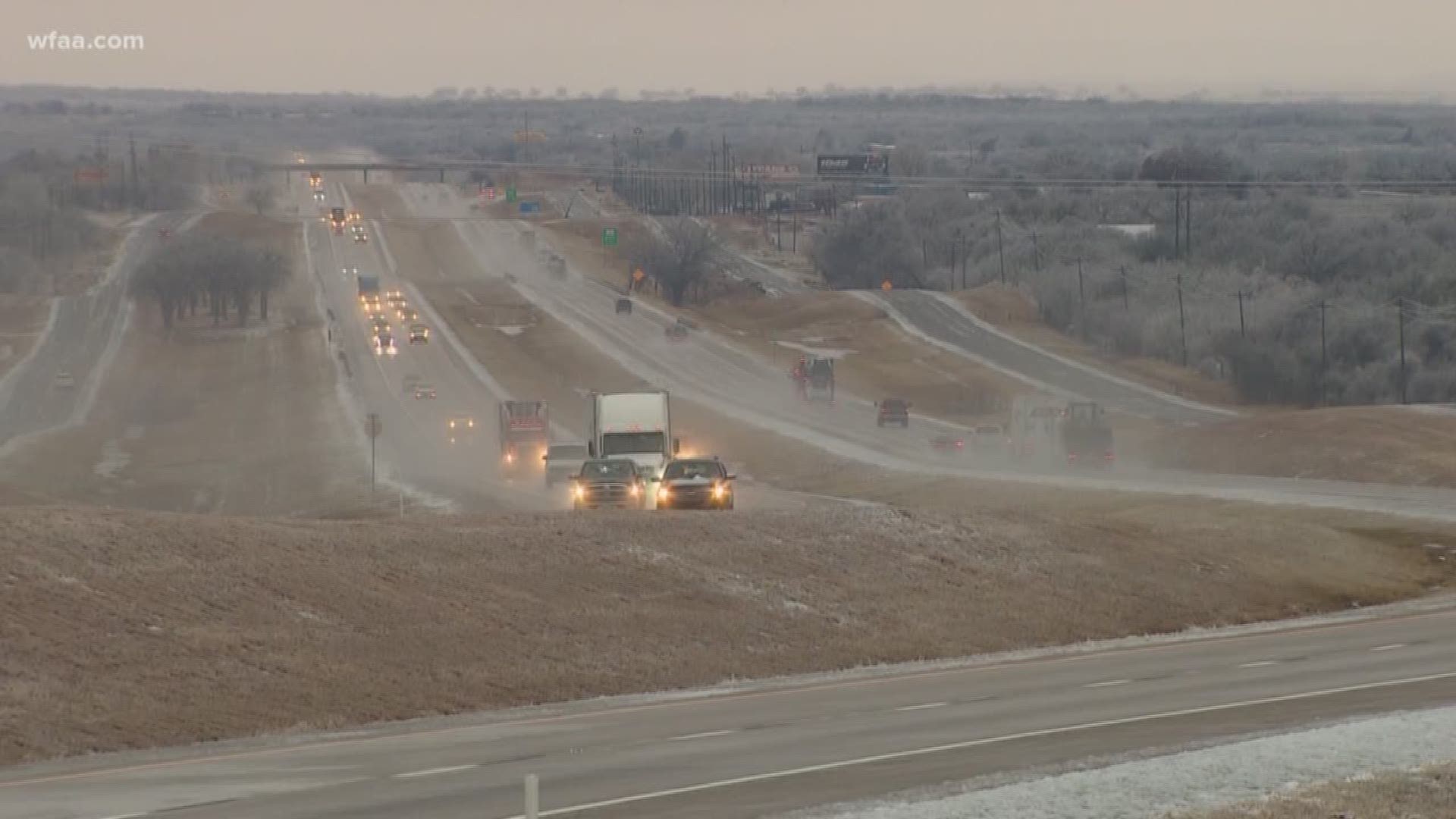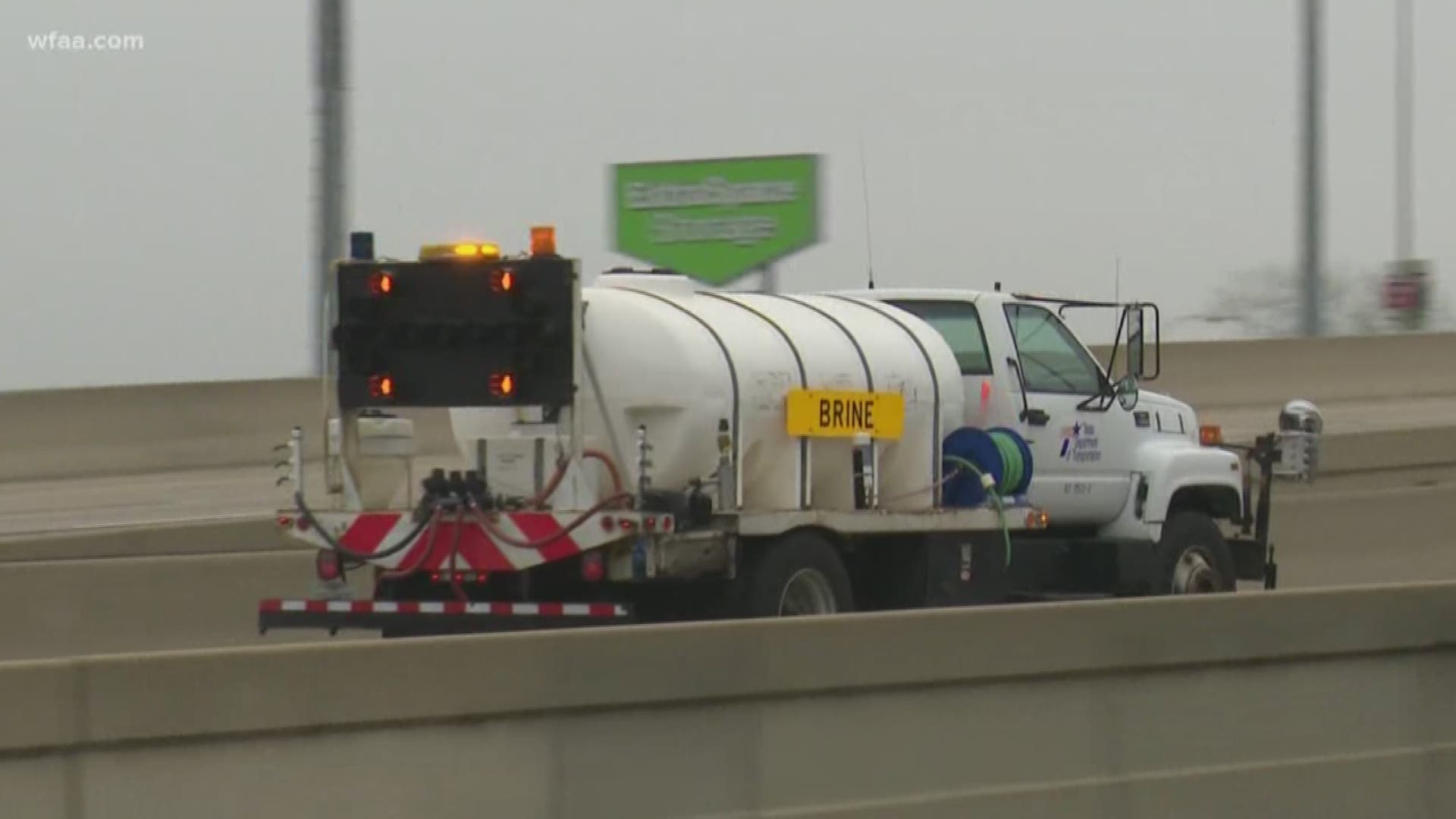DALLAS — Editor's note: The video above is from Dec. 2019.
A Winter Storm Warning has been issued for parts of North Texas in anticipation of winter weather on Sunday.
Snow will start to spread into western North Texas during the pre-dawn hours on Sunday. Then spread into central parts of North Texas (including D-FW) during the morning. Eastern and northeastern North Texas won't see any snow activity until Sunday afternoon.
Here is a breakdown of safety tips for driving in wintry weather from several agencies in North Texas:
AAA Texas
Preparing your vehicle for driving in bad weather
- Clear all snow and ice from the vehicle’s windows, roof, hood, trunk lid, and any other covered areas. This will reduce risk because it increases your visibility. Additionally, drivers around you won’t be blinded by snow blowing off your vehicle.
- Use an ice scraper to remove snow and ice from your windshield and all windows, including side and rear windows. This will improve your ability to see other roadway users that may move into your path of travel.
- To optimize visual clarity, clean the outside and inside of your windshield at least once a week. Frequent cleaning is even more important if you smoke.
- Keep your car’s windshield and rear-window defrosters in good working condition.
- Keep your windshield wiper blades fresh. Many drivers change them every six months, especially before driving in bad weather.
On the road
- Make sure your headlights are on. In fact, it is a good idea to turn on your headlights any time you drive, because you will increase your visibility in any conditions.
- Reduce your speed and leave plenty of room to stop. You should allow at least three times more space than usual between you and the vehicle in front of you.
- Brake gently to avoid skidding.
- Do not use cruise control on any wet, snow-covered or icy roads.
- Be aware of possible icy roads. Be especially careful on bridges and overpasses, which freeze sooner than roads. And even at temperatures above freezing, if conditions are wet, you might encounter ice in shady areas or on exposed roadways like bridges.
- Be careful on infrequently traveled roads, which may not be cleared as often as other roads.
Leaving the roadway
- If you must pull off the road, wait for conditions to improve and pull off the road as far as you can, preferably past the end of a guardrail.
- It is best to pull into a rest area or parking lot, rather than on the road’s shoulder.
Know when to brake and when to steer
- Some driving situations require abrupt action to avoid a crash or collision and in winter conditions the decision to steer or brake can have very different outcomes. When traveling more than 25 mph, AAA Texas recommends steering over braking to avoid a collision in winter-like conditions, as less distance is required to steer around an object than to brake to a stop. In slick conditions, sudden braking can lead to loss of vehicle control.
- However, sometimes steering is not an option. Braking on slippery surfaces requires you to look further ahead and increase following and stopping distances. Plan stopping distances as early as possible and always look 20-30 seconds ahead of your vehicle to ensure you have time and space to stop safely.
Stay in control through a skid
- Even careful and experienced drivers can skid on slippery surfaces. When a vehicle begins to skid, it’s important not to panic and follow these basic steps:
- Continue to look and steer in the direction you want the car to go.
- Avoid slamming on the brakes as this will further upset the vehicle’s balance and make it harder to control.
Additional winter driving safety tips from AAA Texas
- Use your seatbelt every time you get in the vehicle.
- Never warm up a vehicle in an enclosed area, such as a garage.
- Make sure the exhaust pipe isn’t clogged with snow, ice or mud. A blocked exhaust could cause deadly carbon monoxide gas to leak into the passenger compartment with the engine running.
- Never leave your vehicle unattended with the engine running.
- Keep your gas tank at least half full to avoid gas line freeze-up.
Allstate
Keep an emergency kit in your vehicle
- Keep a winter emergency kit in your car that contains necessities such as a brush, warning flares and reflective triangles, a bag of kitty litter or sand for traction, extra clothes, gloves, hand warmers, hats and thermal blankets.
Check your tires and keep at least half a tank of gas in your vehicle at all times
- As temperatures drop, so does the pressure in your tires, says the National Highway Traffic Safety Administration (NHTSA). Look for your vehicle’s correct tire pressure on the tag within the drivers-side doorjamb or in your owner’s manual.
Avoid spinning out on the ice
- Slick surfaces typically require a longer stopping distance, so keep a greater-than-usual distance between your car and other vehicles when roads are snowy and icy, according to the NHTSA. Having this distance may give you ample time to respond to road and weather hazards.
Maintain your car’s battery
- Your engine’s oil thickens as temperatures drop. The thicker the oil, the more power your car battery requires, according to NHTSA. If you know your battery is older than three years, you may want to replace it. If you don’t remember the year it was purchased, you can check your battery’s age by looking at its case.
TxDOT
Tips for getting your car ready for winter travel
- Prepare your vehicle for winter driving by checking its antifreeze, battery, tires, windshield wipers, and lights, including brake lights and blinkers.
- Let others know your route and expected arrival time, building in extra time for delays.
- Put together an emergency roadside kit to keep in your vehicle, just in case. This should include water, snacks, blankets, jumper cables, etc.
Tips for driving in winter conditions
- Slow down and increase the following distance between your vehicle and the one in front of you. It can take twice as long to stop on wet roads and even longer on icy roads.
- Do not use cruise control, which may cause you to lose control on icy surfaces.
- Brake gently, applying slow, steady pressure to test traction.
- Approach turns, bridges and shaded spots slowly. If you find yourself in a skid, stay calm and keep both hands on the wheel. Take your foot off the gas, look where you want to go, and then steer in that direction.
- Keep a safe distance away from snowplows and TxDOT vehicles as they treat roadways.
Tips for driving in fog
- Use low beam headlights and fog lights, if you have them. Do not use high beams (bright lights).
- Slow down and do not drive faster than your field of vision. Use windshield wipers and the defroster to maximize visibility.
- Increase your following distance to ensure enough room for stopping, and avoid sudden stops.
- Use the right edge of the road or roadside reflectors as a guide. If you cannot see, pull off the road completely — preferably at a rest area or truck stop — and turn on your hazard flashers immediately.


